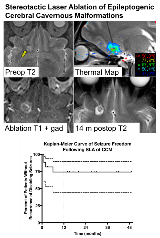Stereotactic Laser Ablation Is a Safe and Effective Treatment for Epileptogenic Cerebral Cavernous Malformations
Abstract number :
2.307
Submission category :
9. Surgery / 9A. Adult
Year :
2018
Submission ID :
501639
Source :
www.aesnet.org
Presentation date :
12/2/2018 4:04:48 PM
Published date :
Nov 5, 2018, 18:00 PM
Authors :
Jon T. Willie, Emory University; James Malcolm, Emory University School of Medicine; Matthew Stern, Emory University School of Medicine; Lindsey Lowder, Emory University School of Medicine; Stewart Neill, Emory University School of Medicine; Brian Cabanis
Rationale: Open resection of cerebral cavernous malformations (CCMs) is effective for treating focal epilepsy, but risks collateral injury. Magnetic resonance (MR) thermometry-guided laser interstitial thermal therapy (stereotactic laser ablation, SLA) is a minimally invasive treatment for focal epilepsy. We describe the safety and effectiveness of ablating epileptogenic CCMs. Methods: We retrospectively analyzed 17 consecutive patients who presented with focal seizures associated with a CCM. Each patient underwent SLA of the CCM and adjacent cortex followed by standard clinical and imaging follow-up. Results: All but one patient (n=16) had chronic epilepsy (median 8 years, range 0.5-52 years) refractory to two or more adequately trialed regimens of medications. Lesions were located in temporal (11), frontal (5, Figure), and parietal (1) lobes. Surgery caused no detectable hemorrhages. Fourteen patients had follow-up >12 months (mean 29 months), 11 of whom became free of disabling seizures from ablation alone (79% Engel class 1 outcome); two were lost to follow-up (69% Engel class 1 by intent-to-treat analysis). Kaplan-Meier analysis of long-term seizure rates following SLA showed no recurrent seizures after 6 months, suggesting durability of therapy (Figure). Two patients who were not seizure free from SLA alone became so following open surgery. Delayed post-surgical imaging, obtained in most patients, validated CCM involution and ablation of surrounding cortex. Histopathological examination of a previously ablated CCM following open surgery confirmed obliteration. Complications included one case of persistent partial superior quadrantopsia from an ablation extending into temporal lobe white matter and one case of hand weakness from ablation in the precentral gyrus. Conclusions: Minimally invasive MR thermometry-guided SLA is a safe and effective alternative to treating epilepsy associated with CCM and presents no barrier to subsequent open surgery when needed. Funding: This work was supported in part by two grants to D. Drane from NIH/NINDS (K02 NS070960 and R01NS088748) and grant funding from Medtronic, Inc. (A1225797BFN:1056035).
